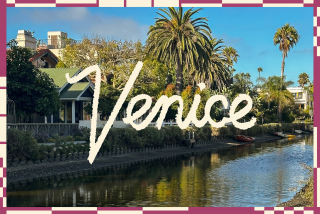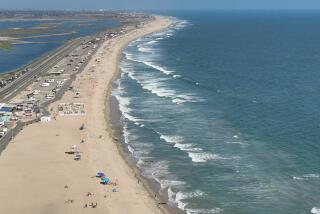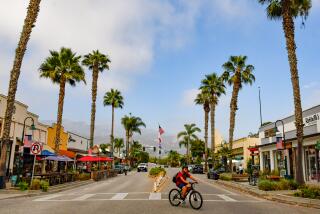La dolce vita on Tuscany’s shores
- Share via
Castiglione della Pescaia, Italy — We were vacationing in Italy — with Rome, Florence and Venice at our fingertips — so why did we spend a week sitting on a beach?
Basically, because I knew my children, Christopher and Francesca, would embrace the idea. At 8 and 6, what’s not to love in a place with an unlimited supply of water and sand? But my husband, Scott, had been hesitant. It was easy to understand why: At the top of his wish list was Rome, a city he had never visited.
My solution was the picturesque coastal town of Castiglione della Pescaia, a two-hour train ride from Rome. We could spend a couple of days in the Eternal City in the middle of our beach stay.
Our trip began in my hometown, the northeastern city of Ferrara, where my family still lives. From there we traveled across Tuscany, leaving Florence and Siena behind. The rolling landscape was an enchanting change for someone like me who had grown up in the flat Padana Plain. The Tuscan hills are dotted with ancient villages that top steep cliffs. Newer sections — identifiable by their redbrick houses — spill down the slopes. Occasionally the zigzagging lines of graceful cypresses could be seen flanking secondary roads. Cultivated land and deep green forests complete the palette of earthy colors that dominates the region.
Castiglione della Pescaia, a town of Etruscan origin, is along the Tyrrhenian Sea at the southern end of Tuscany. Not unlike many charming towns we noticed during our drive, it is a medieval hamlet perched on a cliff and encircled by turreted walls. Crossing the ancient portal into the restored village was like stepping through a time warp. We walked through narrow stone streets to the top of the town’s fortress. Here, on a clear day, the view of the coast extends from Punta Ala in the north to the Uccellina Mountains in the south, including the Tuscan archipelago, from Elba to the Giglio Islands.
The town, which has a port and a long beach, sits in front of a dense pine forest. The house we rented was in the middle of this forest of umbrella-shaped stone pines — a tree native to the Mediterranean — and had a great view of the sea. Our porch was a quiet spot where we could relax every evening when the sun went down behind the next hill. During the day, with temperatures in the high 90s, all we could think of was a refreshing plunge.
This stretch of the Tyrrhenian didn’t disappoint. The golden sand felt a bit hot under our feet, but the water temperature was just right.
A beach full of baths
Italian beaches are known for being hot and crowded in the summer. That’s why we chose to visit in June, when visitors are fewer and temperatures a bit cooler.As is common in Italian seaside resorts, most of the beach is divided into sections, each with its own cafe and small office. Each section is called a bagno, or bath, and is set off by rows of umbrellas. Customers can rent them, together with lounge chairs, at the bagno‘s office. My husband loved the convenience of the arrangement — what parent wouldn’t like having food, showers, restrooms and beach equipment so readily available? We rented an umbrella and chairs, and the children set out for the water, returning only when hungry. Then they assailed us with the zeal of the Turkish pirates who once ransacked these coastal villages.
The beach was an entertaining baby sitter with activities our children devised for themselves, such as building sand castles and playing in the waves. All my husband and I had to do was relax on an inflatable mattress while keeping at least one eye on them. Score one for the Italian beach vacation.
Score another for our bagno cafe, which announced over loudspeakers when each pizza came out of the oven. With service like this, we never wanted to leave the beach.
In the evening, the downtown streets were abuzz with vacationers searching for a cool place to eat. They didn’t have to look far. Castiglione has ample restaurants, some with outdoor tables. Menus feature mainly fish and Tuscan cuisine, with the catch of the day found in a variety of dishes, such as tagliolini with cuttlefish ink, clams and mussels; spaghetti with calamari; orata (bream) in foil; or baked scampi. Sidewalk cafes fill to capacity as customers stave off the evening heat — temperatures decline a bit at night, but humidity doesn’t — with a gelato or a granita.
After dinner, the sounds of the modern world were absent as we walked through the centuries-old fortress. During our leisurely downtown strolls, we discovered two delicatessens, La Bettola and Riserva Naturale, that carried a wide selection of regional specialties, including prosciutto made from wild boar, mortadella, truffles, pecorino cheese, focaccia and other homemade breads, and local wines.
After relaxing at the beach for a few days, we were ready for the hectic pace of a two-day visit to Rome. Our children enjoyed playing in the fountains, climbing the Spanish Steps and visiting the Vatican. They imagined gladiators fighting lions in the Colosseum, and they loved eating gelato.
But by the second day of stomping around Rome, our feet were looking forward to strolling again on the warm sand and in the cool waters of the Tyrrhenian Sea. Our children were delighted when we returned to Castiglione della Pescaia.
A land of cowboys, fortresses
Satisfied that we had explored the town’s beaches thoroughly, we set out on a day trip to look for different ones. We found many choices within an easy hour’s drive. Twenty miles north is the peaceful and elegant resort of Punta Ala, a promontory of dense pine forest surrounded by the sea. Fourteen miles farther north is Follonica — one of the most popular spots on the Tyrrhenian — with fine sandy beaches that stretch four miles. A slight inland detour through the city of Grosseto takes visitors to the towns of Roselle, Buriano and Vetulonia, where Etruscan and Roman ruins offer a view of the past.But interesting stops abound heading south, too, and that’s the direction we took. Castiglione is in the Maremma region of Italy, a region once controlled by Spain. The name Maremma derives from the Spanish word marisma (swamp). At one time, mosquitoes and malaria made the swamps a place of suffering and death. Today the land has been reclaimed, and the area boasts a natural habitat preserved in its original state at Parco Regionale della Maremma (Maremma Nature Park), about 25 miles south of Castiglione.
The park, a blend of marshes, steep ridges and dense Mediterranean thickets, also has medieval towers and abbeys. The land looks much the same to today’s butteri — Tuscan ranch hands — as it did to their ancestors a hundred years ago, when these cowboys were the only inhabitants of the marshy pastures where their herds grazed. The butteri are part of Maremma’s folklore. After all, they defeated Buffalo Bill and his traveling Wild West Show in a challenge of cowboy skills.
Determined to experience new beaches, we drove 20 miles south of the park to the Argentario. This limestone promontory is connected to the mainland by two thin stretches of sandy land where beaches abound. The Argentario itself has a rugged coastline that alternates cliffs with coves and little beaches with gorgeous views of the sea. The landscape, which occasionally becomes wild and inhospitable, is dotted with the remains of forts and towers built during the Spanish domination.
The two ports of the Argentario, Porto Santo Stefano and Porto Ercole, are attractive resorts where palaces and villas climb the cliffs from the sea. Fortresses dominate both harbors, but in the smaller Porto Ercole, the ancient Rocca, or fortress, creates a powerful effect. Smitten with Porto Ercole, we decided to have lunch by the bay.
Other, neighboring towns rich in history also beckoned us during our week at the seashore. Talamone and its fortress overlooking the Tyrrhenian coast, Pitigliano and its breathtaking sunset views, and the thermal baths at Saturnia, famous since Roman times, were just a short day trip away.
If only we had stayed more than a week.
More to Read
Sign up for The Wild
We’ll help you find the best places to hike, bike and run, as well as the perfect silent spots for meditation and yoga.
You may occasionally receive promotional content from the Los Angeles Times.






